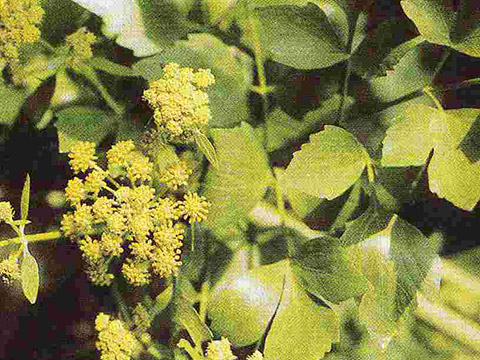Botanical name
Levisticum officinale W.D.J.Koch
Family
Apiaceae
Common name
Garden lovage, Bladder seed, Love Parsley, Maggi herb
Information about the plant
Lovage is originally found in western Asia but has been cultivated throughout Europe for over a thousand years and, since modern times, also in North America. Wild populations can also be found in these regions. Lovage grows in deep, moist, and nutrient-rich soil and is characterized by a spicy aroma reminiscent of celery when the leaves are rubbed between the fingers. This action damages the tissue and the essential oil with its characteristic smell is released from the oil ducts. The story that an industrialist in the food industry - Julius Maggi (1846-1912) - discovered lovage as a source of a tasty soup seasoning and used it as the basis for his globally marketed 'Maggi' is not true. On the contrary, the Maggi company in Singen forbade some garden centers in Berlin, which distributed lovage to schoolchildren in allotment gardens as the 'Maggi herb' after the First World War, from using this name. ‘Maggi' was a legally protected trademark registered with the Reichsparteiamt, and the predicative use of the name, which was reserved exclusively for this company, was not permitted. Nevertheless, the name 'Maggi herb' for lovage has survived in the vernacular.
There is widespread speculation about the origin of the name 'lovage', complicated by the fact that the genus name Levisticum was confused with the genus name Ligusticum for a long time. The plant, which is cultivated as a spice and a medicinal plant, is considered to have originated in Liguria (Latin 'ligusticus' = Ligurian), and underwent various name alterations early on, such as transformations in Medieval Latin to 'levisticum', 'livisticum', and 'lubisticum'; the latter may have given rise to the name 'lovage'. The species epithet officinale suggests that it is an old medicinal plant, as the “officina” is the salesroom of a pharmacy, and 'officinale' means commonly used in the pharmacy.
Lovage is a 1 to 2 m high herbaceous perennial with a strong taproot. The two- to three-pinnate leaves sit on a thick, tubular basal axis with upright protruding side shoots. The lower leaflets are up to 70 cm long and 65 cm wide, shiny dark green, and triangular-rhombic in shape. The small, pale-yellow flowers are borne in large 12 to 20-rayed, domed double umbels. The fruits are 5 to 7 mm long, yellow to brown and split into 2 sub-fruits each after breaking off. The flowering time is from July to August.
Medicinally used parts of plants (herbal drug)
The dried underground parts are used, consisting of the rhizome and the roots (lovage root - Levistici radix).
The commercially available drug is sourced from crops in Thuringia, Poland, the Netherlands, and some Balkan countries.
Constituents of the herbal drug
Lovage roots contain essential oil with alkyl phthalides (including ligustilide), which are responsible for the characteristic spicy aroma of the drug. It also contains coumarins, polyacetylenes, and phenolcarboxylic acids.
Quality of the drug
The quality of lovage root (Levistici radix) is specified in the European Pharmacopoeia (Ph. Eur.).
Medical applications
Recognised medical use
The HMPC has classified lovage root as a traditional herbal medicinal product (see “Traditional use”).
ESCOP: Lovage root has not been assessed.
Herbal drug preparations in finished dosage forms
- Chopped lovage root for tea preparation
- Powdered lovage root in coated tablets
- Aqueous extracts in drops
Dosage
Finished medicinal product: see patient information leaflet.
Tea: Drink a cup of lovage tea 2 to 3 times a day; daily dose 4 to 6 g of the drug.
Preparation of a tea
Pour approximately 150 mL of boiling water over 1.5 to 3 g of finely chopped or coarsely powdered lovage root and strain after 10 to 15 minutes.
Notes
Drink plenty of fluids during flushing therapy.
In the presence of edema due to impaired heart and kidney function, flushing therapy with lovage root should not be undertaken.
No safety studies are available on the use of lovage root during pregnancy and lactation. Its use in children and adolescents under the age of 18 is also not recommended due to a lack of evidence.
Side effects
None known.
Interactions
None known.
References
Herbal drug monographs
HMPC (2013, 2022)
Further literature
Commentary on the European Pharmacopoeia (lovage root, No. 1233)


